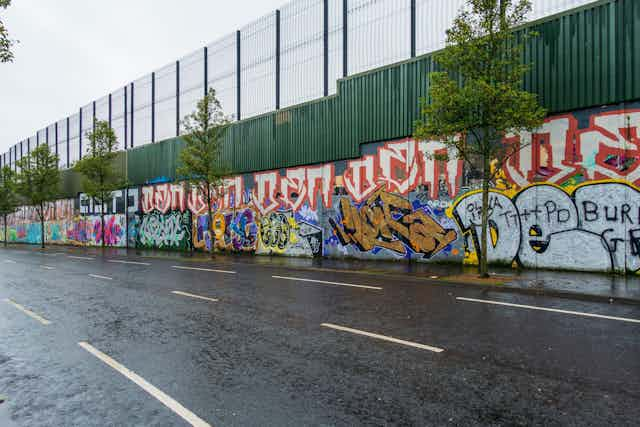In the 25 years since the Good Friday agreement was signed, paramilitarism in Northern Ireland has remained ever-present in some communities. Of the 3,260 instances of paramilitary violence meted out since Northern Ireland achieved peace, 349 have involved children.
These attacks have been shown to form part of an informal system of community “policing”. Both Loyalist and Republican paramilitary groups carry out so-called “punishments” against children accused of anti-social behaviour.
Sociologists, youth workers and community representatives are increasingly framing such attacks as a children’s rights issue. Lobbying from local pressure group Stop Attacks – with which I am affiliated – has led to significant changes in the way the police in Northern Ireland report on these incidents. Instead of labelling them as “punishments”, they are seen as acts of violence constituting human rights abuses.
Recent research has pointed towards children being coerced into joining paramilitary groups and carrying out attacks themselves. My doctoral research looks at how this coercion follows patterns of what criminologists refer to as “child criminal exploitation”.

Child criminal exploitation
Criminologists speak about “child criminal exploitation” to refer to children being forced to commit crime through coercion, grooming, force or debt. In the UK, research has found that child criminal exploitation is central to county lines drugs networks.
These networks extend drug supply beyond urban hubs into suburban and small-town areas for increased profit and reduced competition. They use young people as runners and “shotters” (dealers) to distribute the product, particularly crack cocaine and heroin.
Children are groomed by criminal gangs and made to feel a sense of belonging. But when drugs are lost to police seizure or robbery from rival drug lines, this is not considered the cost of doing business. Instead, children are forced to work to pay them off as debts. They often have to travel across the country to sell drugs from what are known as “trap houses” – places serving local communities with class-A drugs.
To date, most research on child criminal exploitation has been in the context of county lines drugs trafficking. My research looks at child criminal exploitation in the context of both drugs trafficking networks in the London Borough of Tower Hamlets and paramilitary groups in Belfast, Northern Ireland.
Due to the criminality involved in child criminal exploitation, the justice system often fails to recognise that the children affected by this are actually victims. Doing so requires relinquishing the typical distinctions between victim and offender. It means recognising the nuances of the victim experience.
Furthermore, because they are groomed, coerced and exploited, children themselves often don’t recognise their victimhood. This makes protecting them difficult.
A modern slavery issue
In recent years the UK has begun to use victim identification procedures associated with modern slavery to acknowledge and protect victims of criminal exploitation. The national referral mechanism is the UK’s framework for identifying victims of modern slavery. It is a way to ensure they receive appropriate support.
In court proceedings, this mechanism has bolstered legal defences based on modern slavery, particularly in cases related to county lines drug supply. For my doctoral research, I am looking at how “the victim” is defined within this mechanism, to gauge its suitability for identifying victims of child criminal exploitation.

In her 2020 review of the Modern Slavery Act 2015, the UK’s Independent Anti-Slavery Commissioner, Dame Sara Thornton, raised concerns about the potential for the modern slavery legal defence to be abused when used in cases of drugs trafficking:
The operation of the statutory defence is neither adequately protecting victims of trafficking nor adequately protecting the public.
The national referral mechanism has, nonetheless, resulted in more people being identified as victims within the county lines drugs trade. In 2022, 2,281 referrals were related to county lines, 75% of these were for boys.
When it comes to child criminal exploitation from paramilitary groups in Northern Ireland, however, victims are not benefiting from a similar level of protection.
In January 2023, senior youth workers testified to the Northern Ireland Affairs Committee that children were being coerced, by paramilitary groups, into rioting.
This mirrors what is happening within county lines trafficking. In February 2023, Barnardo’s, a charity for vulnerable children, noted a surge in the number of children being lured and coerced into drugs networks with the promise of food, vapes and bicycles, among other “gifts”. The charity’s head of counter-trafficking, Rebecca Griffiths, reportedly told the Education Select Committee that these goods effectively “kickstarted the debt bondage cycle”.
Despite these similarities, children who are criminally exploited by paramilitary groups do not yet benefit from the protection and support that the national referral mechanism offers to victims of county lines drugs networks. This is because child criminal exploitation within paramilitary groups is yet to be recognised as a modern slavery issue in Northern Ireland.
The situations these young people face are complex. However, it is crucial to look beyond labels such as “gang members”, “drug dealers” and “hoods”, to better understand what they are experiencing and how they can be protected.

